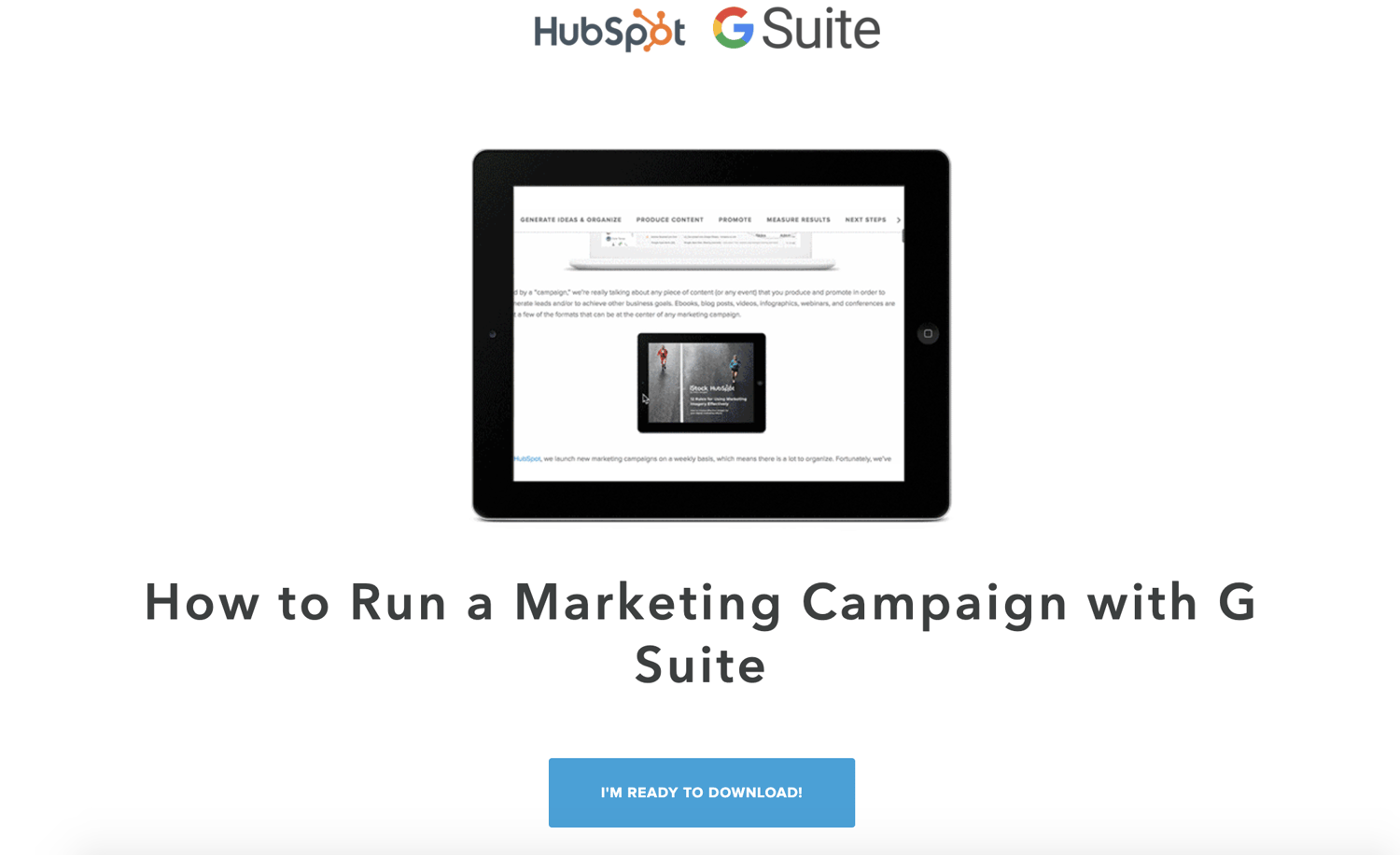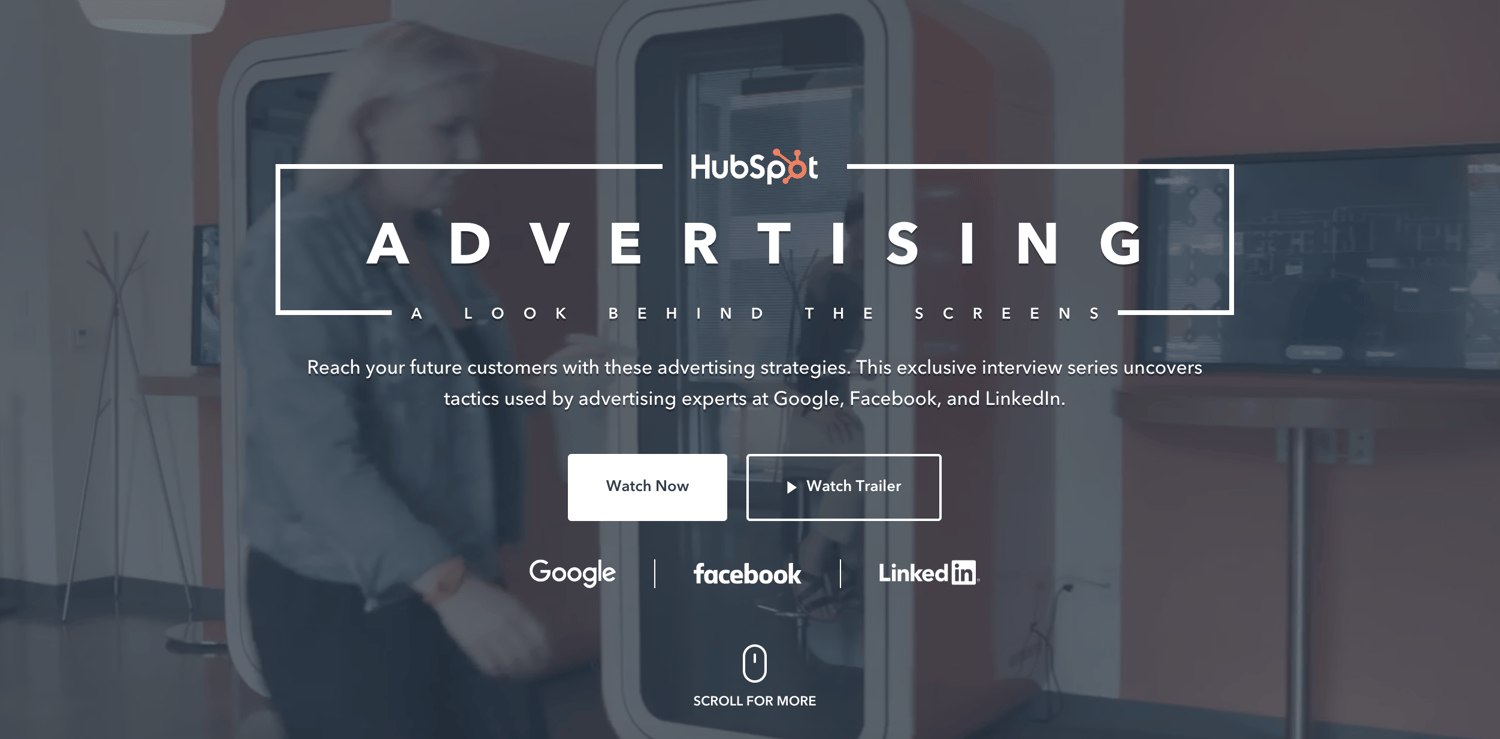As marketers, we are always looking for new ways to get more bang for our buck. Co-marketing allows you to do just that — the process involves two or more companies working together to reap the benefits of their combined efforts.
We’ve compiled the co-marketing tips and tricks below to help you create a successful co-marketing campaign and relationship, from start to finish.
Partner companies typically collaborate on promotional efforts for a co-branded offer. In a co-marketing partnership, both companies promote a piece of content or product, and share the results of that promotion.
By levering the relationship and reach of a partner, co-marketing campaigns are designed to deliver more leads, buzz, and awareness, with less work.
Co-Marketing vs. Co-Branding
You’ve probably heard the terms co-marketing and co-branding thrown around quite a bit — but what’s the difference? Is there one?
Turns out, they’re actually pretty similar.
While co-branding refers to a partnership in which two companies combine their products or expertise to create an even more valuable product or offer (Think: Doritos Locos Tacos), co-marketing takes things a step further.
Co-marketing campaigns provide teams with an opportunity to work together to promote a shared offer — such as a co-branded product or piece of content. In a co-marketing partnership, both companies promote that offer, and share the results of that promotion with each other.
More on how this process works next.
How does co-marketing work?
The most common way to co-market is for two companies that have similar audiences to work together on a piece of content or campaign, and promote it to both audiences.
This content (e.g. ebook, webinar, template, etc.) typically sits behind a lead generation form to capture contact information. The goal is for both partners to share the downloads from the offer, thus getting twice the leads that they normally would.
But that’s not the only way to carry out a co-marketing campaign. Straying from the approach above, two partners might agree to host an event together and split the costs. Or, on a smaller scale, partners could agree to a series of guest blog posts on each other’s sites.
The most important thing when deciding to do co-marketing with a certain partner, is to make sure the purpose and goal of the project is similar for both parties. If one partner wants leads, but another is looking for ticket sales to their annual event, you’ll be hard-pressed to find a project that satisfies both needs.
One aspect of virtually every co-marketing campaign you’ll need is a shared landing page.
Co-Marketing Shared Landing Page
Both your content and landing page should be co-branded — and it should be obvious. This entails using both partner’s logos in the header, and mentioning both partners throughout the content.
Since you will likely be sharing the offer’s downloads with your partner, you will need to consult with your legal team about the proper disclaimer to include at the bottom of the form.
For example, our offer with Google simply states that we are authorized to share their information with the specific partner after a user downloads the ebook.
To keep things organized within your marketing automation tool, we also suggest that you come up with a unique code for naming these co-branded pages to differentiate them from your existing ones. Not to mention, this will make it easy to locate them via internal search.
Next, you may be wondering how you should go about determining which businesses would be good partners for your business. Let’s review the answer to that question next.
How to Find the Right Co-Marketing Partners to Work With
In any co-marketing relationship, you want to make sure there is mutual benefit to working together. Check out tips in determining if a partner is a good fit here.
You can also ask yourself the following questions:
- Do they have a similar type of audience that my company has and wants to grow? If not, the value I would get out of promoting our content to their audience may not be worth it.
- How many new leads am I going to get from this partnership? Is it large enough to be worth my time? Only you can decide what is worth it.
- Do they have some expertise that I don’t have? Let’s say my audience is dying to know more about how to optimize for local SEO, but my knowledge base is limited to general SEO knowledge. Maybe I partner with an expert on local SEO.
- Does their brand and name have a good reputation? Don’t partner with people who will bring down your credibility.
- Are the people you are working with enjoyable to work with? Sure, co-marketing is a job, but it should still be enjoyable. Look for partners that you actually look forward to working with.
How to Plan a Co-Marketing Agreement
You’ve found a partner to work with — that’s great! But, what’s the next step?
1. Come up with an idea to pitch.
Once you determine you’d like to work with a partner, it’s time to come up with an idea to pitch. When approaching this step, do your homework first. Learn what you can about the company and their audience, tailor your ideas to what would be appealing to them, and show them the value you’re going to provide.
Odds are, if you are the one pitching the idea, you are the small fish and they are the big fish. In other words, it’d be easy for them to say no in this scenario. To combat this, go the extra mile to show them that they’d be crazy not to work with you.
If you are on the other end of the pitch, remain open to ideas. Even if the person pitching you isn’t a pro, don’t disregard the opportunity immediately. If it’s a totally unrealistic partnership, be honest with them. And if the idea sounds interesting but it’s just not a great time for you to take on the project, consider adding them to a backlog of potential partners you’d want to work with in the future.
2. Make your goals clear.
If you want leads, make sure your partner knows that. Make sure they also want leads, too. If your goals are misaligned, neither of you will get value you had hoped and planned for out of the relationship.
3. Agree on the content you’ll share and promote.
Next, agree on the type of content you’ll share and promote among your audience. This includes the topic and theme of the content. Decide on a topic that is going to be mutually beneficial and appeal to both audiences.
4. Determine your timeline.
Set a timeline for your co-marketing campaign. This way, everyone is on the same page and gets their portion of the work done on time.
Pro Tip: For a larger project, like an ebook or webinar, double the amount of time it takes your team to write a campaign on your own. This will allow for time for approvals and feedback among your team members and your partner’s team members.
5. Decide what your strong skills are.
Between the your business and your partner’s, it’s likely you both have specific strengths and bring different things to the table. So, assign tasks and work accordingly.
Simply, if you assign tasks related to your co-marketing content and/or campaign based on which partner is better at what, the process will be streamlined and efficient (and likely, a lot more effective among audience members, too!).
6. Write up a formal co-marketing partnership agreement.
Like most things in business, it’s important your co-marketing partnership is solidified and official. To do this, ensure it’s in writing, in a formal agreement. With an agreement in place from the start, you have something to point back at if anything goes wrong or any miscommunications arise. (This may be a legal document or a non-legal document of good faith.)
The details of this agreement should include:
- Topic
- Timeline
- Goals
- Ownership of content and assets (who is creating what?)
- Where the content will be hosted and shared
- Lead-sharing agreements
- Timeframe for promotion
- Promotional plan
- Reporting plan
Types of Co-Marketing Content
Time to decide what type of co-marketing project you’re going to work on. Below are a few common examples to help get the wheels turning.
Ebook
An ebook is a very common form of co-marketing content because it is easy to split up the work — someone lays out the design, someone else writes the content, and so on.
Below is an example of an ebook HubSpot created with the LinkedIn Sales Solutions team:

Blog Post
Co-creating a blog post is one of the lower effort ways to do a co-marketing project. You may also each write a guest post for each other’s blogs. For example, here’s a guest post on the HubSpot blog.

Webinar
Webinars are often the go-to type of co-marketing content. Why? Well, it’s pretty easy to find an expert who is willing to talk for an hour on the topic of their expertise. It is also a well-known format for educational materials. And they’re easy to co-host.
Below is an example of a webinar that HubSpot hosted with partner, HotJar. Users could sign up via a landing page on HubSpot’s site to attend. Now that the webinar is in the past, visitors can still download the recording at this URL.

Video
Creating a video with a partner is a great way to have your message heard by many, while also promoting both of your brands. For example, HubSpot hosted an interview video series with team members from Google, LinkedIn, and Facebook.
Twitter Chat
A Twitter chat is a virtual event where people gather to discuss a common topic. This allows you to show your expertise, and invite and interact with members of both of your target audiences. Also, Twitter allows you to promote your Chat to broaden your reach even more.
Here’s a list of examples of Twitter Chats for your review.
Event (Online or Offline)
Co-marketing can also take form in larger events, both in online or in person. You and your partner may host the event together and brand the entire event in a way that depicts and shares both of your branding and marketing.
Aside from a webinar, you might host a live Q&A. For instance, maybe your business has an employee be an interviewer for the session. Meanwhile, your partner can have one of their team members be the interviewee.
For example, HubSpot’s educational series, Adapt 2020, offers a variety of content but the campaign includes live events that happen weekly. Those who choose to sign up are invited to a live, virtual event where industry experts — including HubSpot executives, HubSpot partners, and more — discuss the chosen topic of the week.

Once you choose the type of co-marketing content you’ll move forward with, it’s time for you and your partner to plan the execution of your campaign.
How to Execute Your Co-Marketing Campaign
There are some steps you should work through to effectively execute your co-marketing campaign with your partner.
1. Outline your co-marketing campaign.
Once you have chosen your topic and form of co-marketing, start with a shared Google Doc — brain dump, collaborate, and outline your plan here.
By using a Google Doc from the start, you your team and your partner’s team can simultaneously edit and add to the details on the Doc. In terms of timing, allow both of your teams about a week or so to hash out and finalize all ideas/ plans in this Doc.
2. Begin content creation.
Once you have agreed on the outline, assigned marketers can jump in and begin content creation. Typically, I split the creation of content between partners by having one partner write and another design, so that voice and design are consistent.
The other option is to have each partner write up and design half of the content, and then fuse the two together. Keep in mind that this will require a thorough consistency check once both parts are brought together.
After the first draft is complete, send to the partner to give feedback or approve. Give ample time between a writing due date and a feedback due date. I like to give a week if I have planned far enough in advance to allow for this.
3. Finalize your campaign content.
During the content finalization period, have your promotional team begin creating the assets needed to promote the content, such as the shared landing page as well as emails, social media images, infographics, blog posts, etc. Since working with a partner will likely take longer than a normal content creation process, this will help to save you some time.
Next, it’s time to promote your co-marketing content.
4. Promote your content.
It’s important to set an agreed upon launch date with the partner. On this date, both teams’ email, social campaigns, and blog promotion should start.
About two or three weeks prior to the launch date, have a brainstorm with all people involved from both teams to discuss what promotional tactics you will use and the timeframe for promotion. Will you both promote the same hashtag on Twitter? What audiences will you be promoting it to?
Below are a few examples of how you can promote your content across various inbound marketing channels:
Blog Posts
Blog posts are a great way to drive traffic to your co-marketing content and offers. Common places to share co-marketing blog content include daily and weekly emails to subscribers, social accounts, and mutually agreed upon areas that you can reach target audience members. For example, at HubSpot, this content may be shared via HubSpot Academy.
Social Media
Promoting your content on social media is a great way to drive awareness to your co-marketing campaign and attract visitors to your site and content.
Remember, tag your your co-marketing partner and ensure they do the same while sharing content that involves your business. This is easy to do and you’ll benefit from the cross-promotion as members of each other’s audiences will be able to view and interact with the content.
Email is still one of the best ways to reach a large group of people at once — you can easily encourage recipients to attend your co-marketing webinar or event, or download your content.
In your message, be clear that the email involves your brand and your partner — your co-marketing efforts should be clear, meaning it’s obvious to all recipients that there are two companies involved.
If you’re looking to track your partner’s promotions efforts versus your own, be sure to create unique tracking URLs. This will help you determine which leads came from where. If you’re a HubSpot user, here’s how you can create unique tracking URLs.
Speaking of tracking, let’s talk more about how to measure your co-marketing efforts.
5. Measure your co-marketing campaign’s results.
Your co-marketing campaign is live and being promoted — good work! Now it’s time to look back and see if your initial efforts were successful.
First and foremost, did you hit your original goal? If so, great. If not, why? What happened? Did you fail to hit the mark, or was it the partner? Keep these things in mind when making decisions to work with them a second time.
Next, look to see if the leads generated through your co-marketing campaign were as high-quality as the leads you typically generate throughout your individual content and campaigns. Things to consider here are: lead-to-customer conversion rate, quality rating within your automation tool and CRM, and whether or not your sales team felt the leads were up to par.
Finally, take a step back and ask yourself the following questions, too:
- Was the partnership successful, in your opinion?
- Did your partner feel like the relationship was a helpful one for the campaign?
- Was it difficult to work with your partner, or smooth?
- Did you get high-quality content that you may not have been able to make without your partner?
- What worked well while working with this partner, and what didn’t?
Once the campaign is over, your partnership doesn’t end. You should follow up with your co-marketing partner at this point.
6. Follow up with your co-marketing partner.
Communication with your partner throughout the co-marketing campaign if critical but you’ll also want to debrief once the campaign comes to an end. While it typically doesn’t make sense to do one project after another with the same partner, there may be an opportunity to work together again in the future.
And if not, it’s still important to keep a positive image for your brand and remain professional, no matter the outcome of the campaign.
For instance, imagine you hosted a campaign’s landing page on your website. Once the campaign ends, send over the leads generated from your form on that page to your partner. Often times, the easiest way to do this is to simply download the CSV file of leads from your database. If you are looking for a less manual process, you might use a tool like Zapier to send specific leads from your marketing automation platform to your partner’s.
Grow Better With Co-Marketing
There are so many ways for you and partners to benefit mutually from co-marketing. Don’t be afraid to experiment with different types of campaigns and try working with different partners. This will help you determine what works best among your audience and, therefore, benefits your business most.
Editor’s Note: This post was originally published in March 2013 and has been updated for accuracy and comprehensiveness.
![]()
Original Entry: What Is Co-Marketing? A Guide to Co-Branding Marketing Campaigns is shared from https://blog.hubspot.com/blog/tabid/6307/bid/34188/what-in-the-heck-is-co-marketing.aspx via https://blog.hubspot.com/marketing
Check out the original post, What Is Co-Marketing? A Guide to Co-Branding Marketing Campaigns that is shared from https://putyourfamilyfirst.wordpress.com/2020/08/05/what-is-co-marketing-a-guide-to-co-branding-marketing-campaigns/ via https://putyourfamilyfirst.wordpress.com


No comments:
Post a Comment